Identification Guide to Land Snails and Slugs of Western Washington
by Timothy A. Pearce, Casey H. Richart, William P. Leonard, and Paul A. Hohenlohe
©
![]()
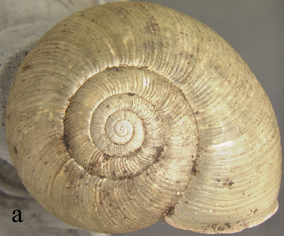

10a. Shell well developed, coiled, large enough to accommodate the withdrawn body of the animal; these are the shelled snails. 20
10b. Shell lacking, or if present then too small to accommodate the withdrawn body of the animal; these are the slugs and semi-slugs. 370
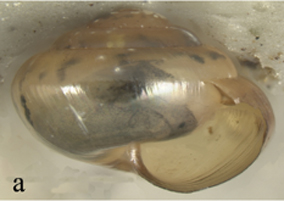
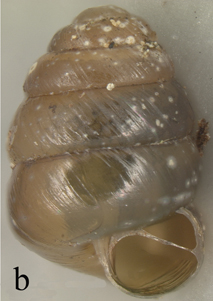
20a. Shell wider than high (or about as wide as high); size variable. 30
20b. Shell height greater than 1.5 times shell diameter; shell height less than 15 mm. 280

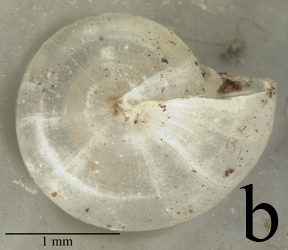
30a. Full-grown shell greater than or equal to 4mm diameter; umbilicus usually open; all shells 4 to 8 mm diameter have an open umbilicus and at least 5.5 whorls. 40
30b. Full-grown shell less than 4 mm in diameter (snails in this choice are full-grown at 3 to 6.5 whorls); umbilicus closed or open; shells 2.5 to 4 mm diameter have a closed umbilicus and at least 4 whorls. 180
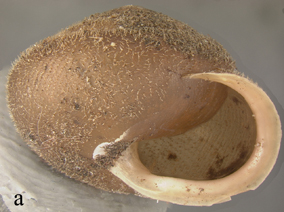
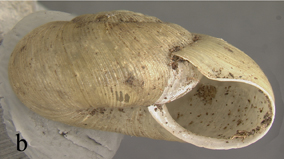
40a. Shell lip in full-grown shells broadly reflected; last whorl descends. Polygyridae. 50
40b. Shell lip thin or thickened, but not reflected; last whorl may or may not descend. 80
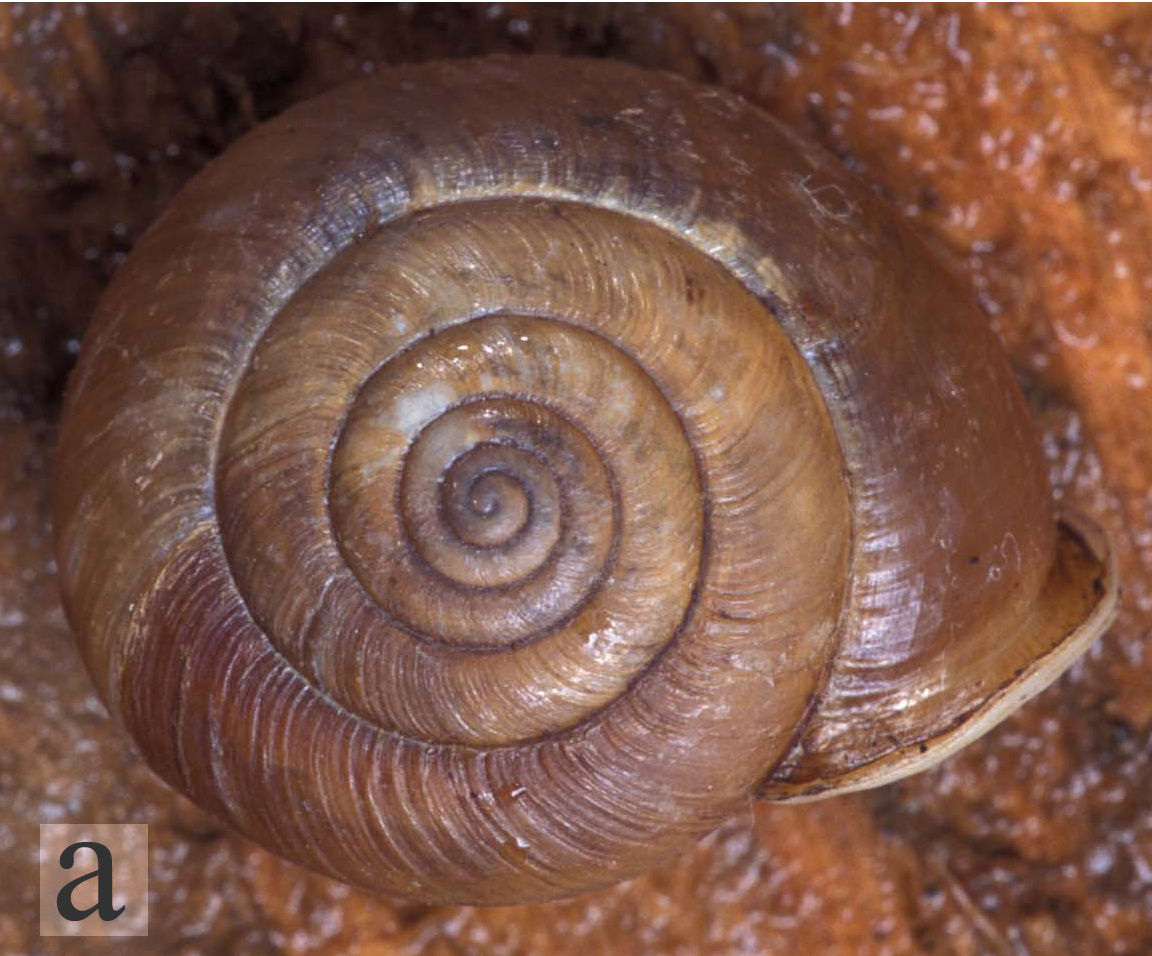

50a. Full-grown shell = 20 mm in diameter, without hairs on tan or brown shell;
shell surface with microscopic spiral lines. 60
50b. Full-grown shell < 17 mm in diameter, shell usually covered with short,
fine hairs, shell brown; shell surface without microscopic spiral lines; umbilicus
about 10% or less of diameter and in full-grown shells partly covered by the
broadly reflected lip. 70
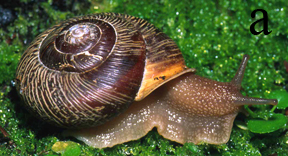
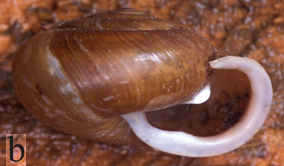
60a. Full-grown shells (with a reflected lip) lacking a tooth-like structure in the aperture; whorls with prominent longitudinal striations; shell 24 to 35 mm diameter. Allogona townsendiana
60b. Full-grown shell (with a reflected lip) having a prominent tooth-like barrier in the aperture; shells 20 to 23 mm diameter when fully grown. Cryptomastix devia

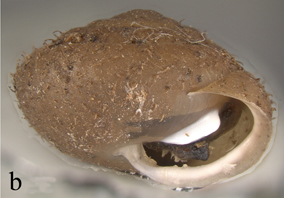
70a. Shell lacking a long, narrow tooth-like structure in the aperture; shell up to 17 mm diameter. Vespericola columbiana
70b. Full-grown shells (with a reflected lip) bearing a long, narrow tooth-like barrier in the inner edge of the aperture; shell up to 8.5 mm diameter. Cryptomastix germana
80a.
Shell diameter less than 5 mm; shell whorls tightly coiled in apical view,
the last whorl less than 1.8 times wider than
the previous whorl; umbilicus
20 to 25% of shell diameter. Microphysula cookei
80b. Shell diameter 6 to 40 mm diameter; shell coiling tightness variable 90.
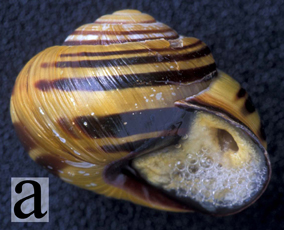
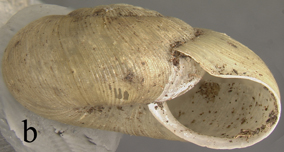
90a.
Shell less flattened, diameter 1.1 to 1.6 times height; shell usually with
color bands; full-grown shell > 24 mm;
last part of last whorl descends 100
90b Shell more flattened, diameter 1.8 to 2.5 times height; shell without color
bands; full-grown shells < 32 mm; last part of last whorl may or may not
descend 120
![]()
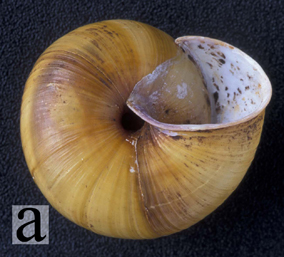
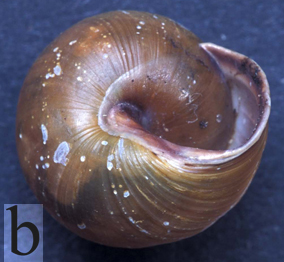
100a. Shell lip thickened but not broadly reflected in outer part of lip in full-grown shells, lip is partially reflected near umbilicus; umbilicus open, about 10% of shell diameter; shell dark brown with one or more bands or stripes along periphery (yellowish morph encountered occasionally); native species, generally found in more natural settings. Monadenia fidelis
100b. Shell lip reflected in full-grown shells; umbilicus closed by reflected lip in full-grown shells; shell with a yellowish or tan background, with or without color bands; introduced from Europe, generally found in more disturbed settings 110
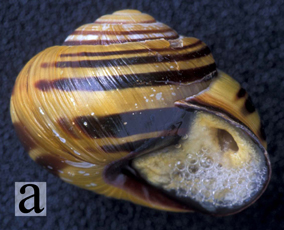

110a. Shell less than 25 mm diameter; color
bands on shell continuous but not always present, 0 to 5 bands; shell more
depressed, diameter about 1.3 times height; shell whorls more tightly coiled,
width of last whorl in apical view less than 1.5 times width of previous whorl.
Cepaea nemoralis
110b. Full-grown shell generally more than 30 mm diameter; color bands on shell
always present and interrupted by yellow flecks or streaks, 3 bands; shell
not depressed, shell diameter about 1.1 to 1.2 times shell height; shell whorls
less tightly coiled, width of last whorl in apical view more than 1.5 times
the width of the previous whorl. Helix aspersa
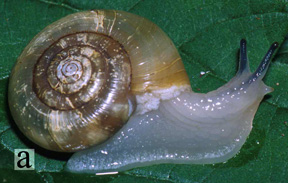

120a. Shell greenish-yellow or olive (rarely
chocolate brown), opaque or nearly so; full-grown shells 11 to 34 mm diameter;
shell lip may be thickened or not; body of animal white (head and tentacles
may appear gray); native species found in less disturbed situations; may be
carnivorous or not. 130
120b. Shell brown or amber, nearly transparent; full-grown shells 6 to 16 mm
diameter; shell lip never thickened; body of animal pale gray to black; species
introduced from Europe, common around greenhouses and gardens; carnivorous,
eating snails and other invertebrates. Oxychilus 160
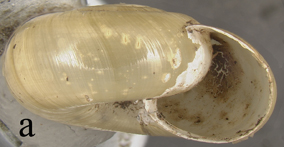

130a. Shell surface glossy, no trace of spiral lines, weak growth wrinkles present; shell lip edge not thickened in full-grown shells, upper lip not bent downward in full-grown shells; umbilical side of aperture termination in full-grown shells not expanding toward umbilicus; full-grown shells without a ventral constriction in the last whorl just before the lip; upper insertion of aperture higher on previous shell whorl; not known to eat other snails. Megomphix hemphilli
130b. Shell surface not glossy, spiral lines present, at least on the spire, growth wrinkles more prominent; shell lip edge in full-grown shells is thickened and upper edge of aperture is usually straightened or dips downward; umbilical side of aperture termination in full-grown shells expanding slightly toward umbilicus; full-grown shells often with a ventral constriction in the last whorl just before the lip; upper insertion of aperture a bit lower on previous shell whorl; snails are carnivorous, eating other snails, also known to eat plants. Haplotrematidae 140
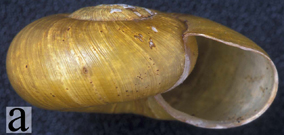

140a. Radial striations on shell microscopic and wrinkle-like, often irregular; upper lip of shell aperture is straightened and sometimes dips downward; full-grown shells 18.5 to 34 mm diameter. Haplotrema vancouverense
140b. Striations on shell with minute beaded sculpture of spiral lines cutting the tips of the regular radial growth ridges, at least on the spire (beaded sculpture easily seen within umbilicus); upper lip of shell aperture with a strong downward dip; full-grown shells 11 to 25 mm diameter. Ancotrema. 150
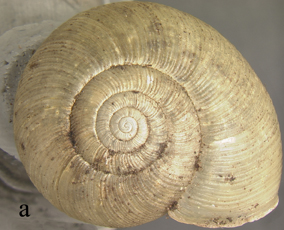
150a. Beaded sculpture on entire shell surface composed of regular growth ridges cut by spiral lines; sculpture is strong on spire and on last whorl; full-grown shells 11 to 22 mm. Ancotrema sportella
150b. Beaded sculpture absent from last whorl, but present within umbilicus
and usually on spire; sculpture on last whorl is reduced to low wrinkles with
spiral
striations microscopic or nearly absent; full-grown shells 15 to 27 mm diameter.
Ancotrema hybridum
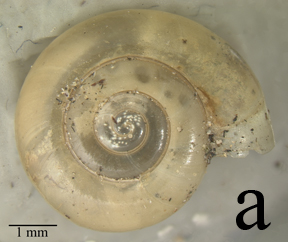

160a. Full-grown shell 6 to 7 mm diameter, with 4 to 4.5 whorls, highly polished; animal very dark (black); living animal smells of garlic. Oxychillus alliarius
160b. Full-grown shell 9 mm or greater in diameter, with 5 to 5.5 whorls; animal either very pale or very dark; not smelling of garlic 170

170a. Full-grown shell about 9 mm diameter, with 5 whorls; last whorl expands more slowly, width of last shell whorl 1.6 to 2 times width of penultimate whorl; animal is pale gray. Oxyhillus cellarius
170b. Full-grown shell 12 to 16 mm diameter, with 5 to 5.5 whorls; last whorl expands more rapidly, width of last shell whorl about 2.1 times width of penultimate whorl; animal is dark blue-black or blue-gray. Oxychillus draparnaudi
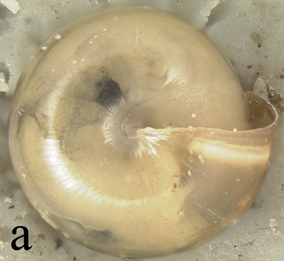

180a. Umbilicus of shell minute to completely closed; 3.8 to 6.5 whorls in full-grown shells; full-grown shells 2 to 3.8 mm in diameter. 190
180b. Umbilicus wide, 23 to 33% of shell diameter; 3 to 4.25 whorls in full-grown shells; full-grown shells 1 to 2.4 mm in diameter. 240
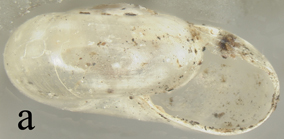
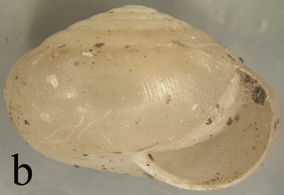
190a. Shell flatter, diameter 2 to 2.4 times shell height; shell whitish; full-grown shells with 4 or fewer whorls; whorls increasing more rapidly, the last whorl 2.4 times width of previous whorl. Pristiloma johnsoni
190b. Shell less flat, diameter 1.2 to 1.7 times shell height; shell brown; full-grown shells with 5 or more whorls; whorls more tightly coiled, last whorl less than 1.4 times width of previous whorl 200
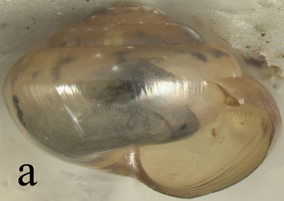

200a. Upper lip of shell aperture joins previous whorl below the periphery of previous whorl (in lateral view); shell spire more conical, spire height (above final whorl) 40% or more of final whorl height; upper surface with very fine radial striae (use high power microscope), 90 to 105 striae per mm; umbilicus minute to closed; aperture more open. Euconulus fulvus
200b. Upper lip of shell aperture joins previous whorl well above the periphery of previous whorl (in lateral view); shell spire more depressed, less than 30% of final whorl height; upper surface either smooth, or if radial sculpture present, radial lines are fewer than 15 striae per mm; shell surface glossy; umbilicus completely closed; aperture narrow. Pristiloma. 210
![]()
Found among fallen leaves. The record for Pristiloma wascoense, tentatively identified from the Olympic Mountains near Port Angeles by Branson (1997), needs confirmation. Pristiloma wascoense is about 2 mm in diameter, has a narrow umbilicus, and had been previously reported from Oregon in Wasco County and near Salem, Marion County.
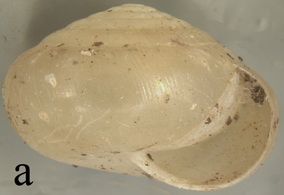

210a. Shell sculptured above with distinct impressed growth lines 220
210b. Shell smooth throughout or with only very weak growth lines 230

220a. Growth lines on shell crowded, not very deep, 10 to 15 striae per mm; periphery of shell about at middle of shell height when viewed laterally; full-grown shells 3.4 to 3.8 mm diameter, with about 6.3 whorls. Pristiloma stearnsi
220b. Growth lines on shell more widely spaced, 6 to 8 per mm, deep and separated, giving the appearance of a corona of low tubercles at the edge of the whorls; periphery of shell above middle of shell height when viewed laterally; full-grown shells 2.6 to 3.4 mm diameter, with about 5.5 to 6.5 whorls. Pristiloma pilsbryi
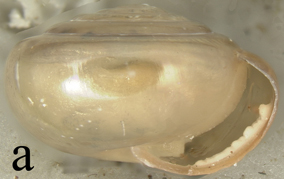

230a. Shell usually with an irregularly denticulate rib within the outer
margin of the lip; periphery of shell above the middle when viewed laterally. Pristiloma
lansingi
230b. Shell lip thin, lacking a rib; periphery of shell about at middle when
viewed laterally. Pristiloma arcticum
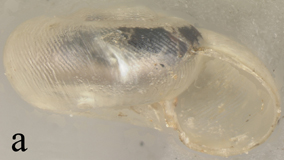
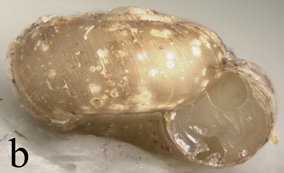
240a. Shell pale greenish-yellow to white; flattened, shell diameter 1.85 to 2 times height; whorls less tightly coiled, width of final whorl 1.5 to 1.7 times width of previous whorl 250
240b. Shell brown to reddish-brown; less flattened, shell diameter 1.3 to 1.82 times height; whorls more tightly coiled, width of final whorl 1.1 to 1.3 times width of previous whorl 260


250a. Lip of full-grown shell is thickened, flared, and reflected; shell surface smooth, without regular striations; full-grown shell diameter 2.4 mm; more tightly coiled, width of the last whorl 1.5 times width of previous whorl. Vallonia pulchella
250b. Lip not thickened and not flaring; shell surface with minute regular radial striations; shell diameter 1.5 to 1.7 mm; more loosely coiled, width of the last whorl 1.7 times width of previous whorl. Striatura pugetensis

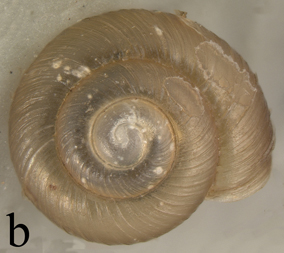
260a. Shell with radial ribs prominent and widely spaced, no smaller radial striae between ribs (although spiral striae are present); shell flattened, spire low, shell diameter 1.65 to 1.85 times shell height. Planogyra clappi
260b. Shell with fine growth lines or less prominent ribs, if ribs present, then finer radial striae are present between the larger ribs; shell taller, shell diameter 1.3 to 1. 7 times shell height 270


270a. Shell minute, diameter 1.1 to 1.3 mm with 3.5 to 4.3 whorls; shell surface with very fine growth lines, not ribs, all about the same size; shell diameter 1.35 to 1.5 times height. Punctum randolphi
270b. Shell less minute, diameter 1.5 to 2.0 mm with 4 to 4.3 whorls; shell surface with small, widely spaced riblets having usually five or more smaller radial striae in the interspaces between each pair of major riblets; shell diameter 1.6 to 1.7 times height. Paralaoma servilis
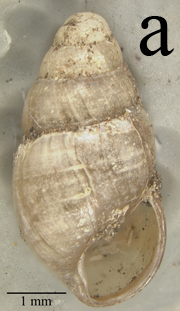
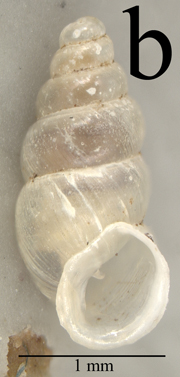
280a. Full-grown shell 5 mm or more in height. 290
280b. Full-grown shell 3.5 mm or less in height 310

290a. Height of shell aperture about 33% of shell height, shell surface
glossy; shell spindle shaped.Cochlicopa lubrica
290b. Height of shell aperture nearly half or more of shell height; shell not
glossy; shell regularly tapering 300
300a. 30a(29) Shell aperture bearing teeth or lamellae; sparse hairs on shell spire; shell narrower, height about 2.25 times diameter; found in salt marshes Mysotella myosotis
300b. Shell aperture lacks teeth or lamellae; shell without hairs; shell broader, height about 1.5 to 1.7 times diameter; often found in moist areas near freshwater, but usually not found in salt marshes. Succineidae
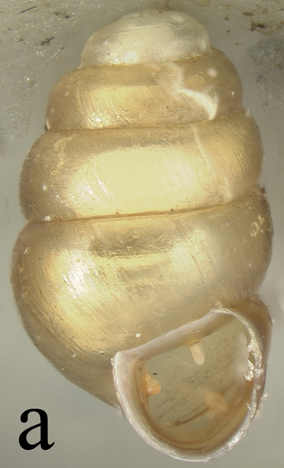
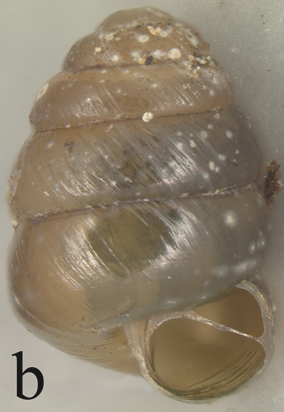
310a. Aperture of full-grown shell with teeth or lamellae 320
310b. Shell aperture lacking teeth or lamellae at any stage 350

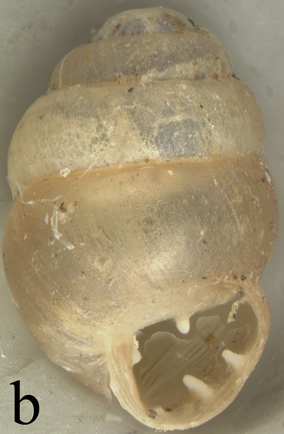
320a. Shell bearing one tooth-like lamella on the inner edge of the aperture (lamella continues through the shell’s interior and is visible in both juvenile and full-grown shells); shell translucent whitish, conic and regularly tapering; full-grown shells with a strongly reflected lip; head of animal with one pair of tentacles and eyes at base of tentacles. Carychium occidentale
320b. Shell bearing 4 to 6 tooth-like barriers in the aperture; shell brown, translucent, oblong in shape; shell lip not reflected but may be slightly thickened in full-grown specimens; head of animal without tentacles. Vertigo 330
330a. Aperture with 5 to 6 teeth with larger, more recessed teeth, especially the columellar tooth (on left side of aperture) ascends a little inwardly; aperture width greater than half shell width; lower right edge of aperture more angled, less vertical (in apertural view); shell stouter with penultimate whorl nearly same diameter as final whorl; shell usually smaller, 1.9 to 2.1 mm tall. Vertigo andrusiana
330b. Aperture with 4 teeth; aperture width about half of shell width; lower right edge of aperture more vertical (in apertural view); shell generally less stout with penultimate whorl usually smaller in diameter than final whorl; shell usually larger, 2.3 to 2.7 mm tall. 340
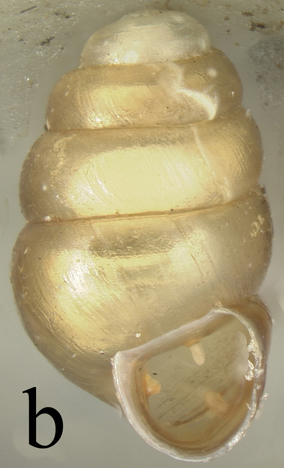
340a. Outer lip more rounded, teeth smaller, set closer to the lip edge, lower palatal tooth short, not extending inward as far; shell 2.3 to 2.7 mm tall. Vertigo modesta
340b. Shell smaller, 1.9 to 2.1 mm tall; 4 teeth in aperture; outer lip slightly flattened, teeth larger, set slightly inward from the lip edge, lower palatal tooth longer, extending inward. Vertigo columbiana
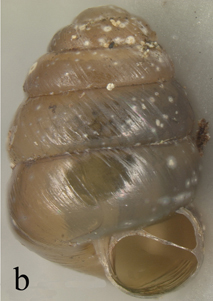
350a. Shell truncate with upper whorls broken off; shell more slender (height about 2.7 times width); found among oyster shells and under organic debris at higher levels in salt marshes. Cecina manchurica
350b. Shell with early whorls intact; shell less slender (1.5 to 1.6 times
width) 360
![]()

360a. Shell cylindrical and oblong in shape, not conical; height of shell
aperture less than a third of shell height; living animal lacks operculum (horny
flap for closing the aperture); in leaf litter and on vegetation in woods,
not found in salt marshes. Columella simplex
360b. Shell regularly conical; height of shell aperture nearly half of shell
height; living animal bears an operculum (a horny flap for closing the aperture);
found under debris and vegetation at higher levels in salt marshes. Assiminea
californica


370a. Animals with a small external shell; either having a conspicuous mantle pouch (containing the internal organs) with a partly exposed horny plate at the posterior end of the mantle, or lacking a mantle but having a small, loosely coiled shell at the posterior end of the body. 380
370b. Animals without external shell; no conspicuous pouch on back, internal organs within foot 420

380a. Animal with a small, ear-shaped shell at posterior end of body; without conspicuously raised mantle hump; shell resembling that of an abalone, whorls of shell rapidly expanding. Testacella haliotidea
380b. Animal with a small, thin, partly exposed horny plate near posterior end of mantle hump; mantle hump conspicuously raised in a visceral pouch centrally located on body; internal organs in mantle pouch, not within foot; able to twitch violently if disturbed by thrashing tail (hence common name, jumping slugs); foot fringe wide; breathing hole in posterior half of right side of mantle; Hemphillia. 390
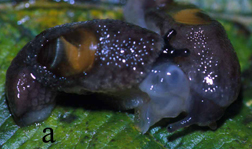

390a. Mantle covered with conical papillae; length of tail < length of mantle when animal fully extended in movement; smaller slugs up to about 20 mm long; tail keel high (expanded upward) and laterally compressed; tail with pale mid-dorsal stripe; (caution should be exercised in these determinations as additional undescribed species are likely to occur). 400
390b. Mantle mostly smooth; length of tail > length of mantle when animal fully extended in movement; larger slugs, full-grown slugs more than 30 mm long; tail keel not markedly raised; tail with or without pale mid-dorsal stripe. 410

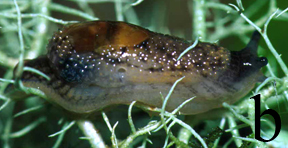
400a. Row of small dark spots present where body grooves meet the pedal groove above edge of sole; body grooves are somewhat pigmented on back half of body. Hemphillia burringtoni
400b. Without dark spots, or dark spots less distinct, where body grooves meet the pedal groove above edge of sole; body grooves may or may not be pigmented. Hemphillia glandulosa
![]()
401. ?
{mention H. pantherina here?}
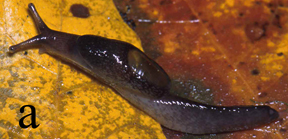

410a. Slender; dark brown or gray body; lacking a pale mid-dorsal stripe on tail; caudal horn usually present. Hemphillia dromedarius
410b. Robust; body variable in color; light-colored, pale mid-dorsal stripe present on tail; caudal horn absent. Hemphillia malonei
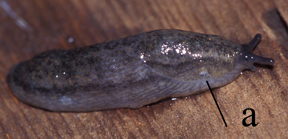
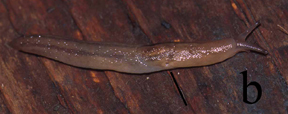
420a. Breathing hole in front half of right side of mantle (may be quite near middle); back usually not keeled; sole not longitudinally divided into three sections … Arionidae (in part). 430
420b. Breathing hole in posterior half of right side of mantle; back usually keeled on posterior portion; sole may or may not be longitudinally divided into three sections. 550

430a. No caudal pore; many specimens have a constriction on the tail (usually difficult to discern in P. vanattae) at which the animal is capable of self amputation if disturbed; if lateral pigment bands are present on the mantle, right band passes above the breathing hole; native species. Prophysaon. 440
430b. Pedal grooves meet posteriorly in a caudal mucous pit; if lateral bands are present on mantle, then the right band either encloses or passes above the breathing hole; introduced from Europe; usually not far from areas inhabited by humans. Arion. 490
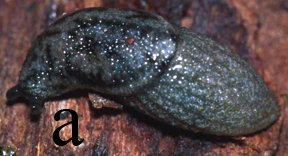

440a. Without a light colored dorsal stripe on tail; black lateral bands behind mantle present or absent; tail surface sculpture of longitudinal grooves or indistinct pattern but not reticulate mesh grooves; slugs up to 50 mm long; lateral mantle bands present or absent; sole pale to dark. 450
440b. Having a light colored mid-dorsal stripe on tail; without black lateral bands behind mantle; tail surface with finely reticulate grooves in a diamond mesh pattern, reticulations marked in gray; slugs up to 100 mm long; lateral mantle bands usually present; {sole very pale to white}. 480


450a. Longitudinal grooves on tail prominent and parallel; no longitudinal lateral stripes on body behind mantle; a line of abscission at about the posterior fourth of the body runs obliquely downward along the sides about 4 mm anterior of the posterior end of the foot. 460
450b. Longitudinal grooves on tail lacking or indistinct; with longitudinal lateral stripes on body behind mantle. 470
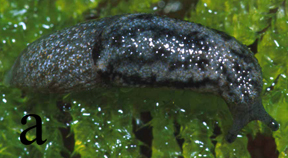

460a. Mantle and tail covered with numerous cone-shaped papillae; usually with dark markings on mantle. Prophysaon dubium
460b. Mantle lacking cone shaped papillae; without dark markings on mantle. Prophysaon coeruleum
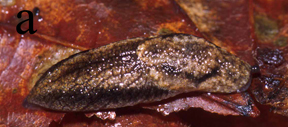
470a. Mantle color variable, but not black; body with a conspicuous black band on each side of the body laterally behind mantle, enclosing a lighter wedge-shaped dorsal area, which encloses a wedge shaped darker median stripe (sometimes faint); sole usually cream colored. Prophysaon vanattae
470b. Mantle black; body gray, very dark above, with or without obscure dark lateral bands on tail; sole dark gray. Prophysaon obscurum


480a. Smaller, 30 to 62 mm long; mantle without a narrow yellow border; lateral mantle bands, when present, are solid; strong internal shell; tail constriction may be marked by a gray line on the sole. Prophysaon andersoni
480b. Larger, 50 to more than 100 mm long; mantle often with a narrow, bright yellow border; lateral mantle bands always present, and broken or irregular; internal shell delicate, membranous; tail constriction usually not marked by a gray line on the sole. Prophysaon foliolatum
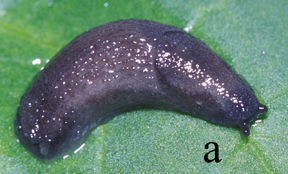

490a. When animal contracts, dorsal tubercles are cone shaped with transparent tips giving a hedgehog appearance; over pedal groove at anterior is usually a horizontal row of dark dots; if lateral mantle bands are present, then the right band encloses the breathing hole. Arion intermedius
490b. Tubercles not cone shaped and without transparent tips when animal contracts; without dots at pedal groove at anterior end; if lateral mantle bands are present, the right band either encloses or passes above the breathing hole. 500
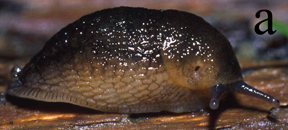
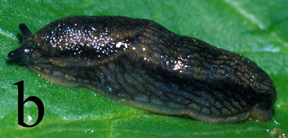
500a. Foot fringe wide and bearing numerous dark vertical lines (sometimes confined to the posterior in A. subfuscus); lateral dark bands present or absent, when present, band encloses breathing hole; large slugs, often greater than 50 mm long. 510
500b. Foot fringe not conspicuously wide, and without dark, vertical lines; a lateral dark band always present on each side of the mantle and body; breathing hole within or below lateral mantle band; generally less than 50 mm long. 520 a 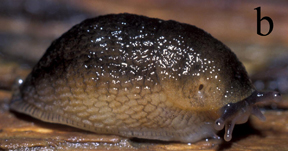
510a. Large bulky animals 70 mm to more than 150 mm long; usually a solid color, black or reddish brown; tubercles on side and back coarse or elongated; mucus usually clear or white (occasionally may be yellowish or orange); full-grown slugs lack bands on mantle, but when bands are present, there are about 10 or more tubercles between bands counted just behind the mantle. Arion rufus
510b. Length 50 to 80 mm; tubercles not conspicuously coarse or elongate; full-grown slugs usually with lateral bands (may be lacking); body mucus yellow or orange, at least when disturbed, sole mucus usually colorless; if bands present on mantle, then right band enclosing breathing hole; 12 or more tubercles between bands counted just behind mantle. Arion subfuscus

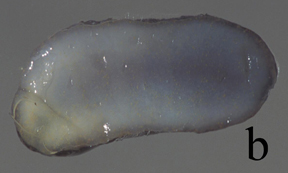
520a. Sole yellow to orange; foot mucus yellow or orange; without a pale dorsal line; contracted body nearly circular in cross section; lateral mantle band usually encloses breathing hole. Arion distinctus
520b. Sole white to gray; foot mucus usually clear or pale yellow; tubercles behind mantle pale and raised to form a pale longitudinal ridge (may be faint or lost in some full-grown slugs); contracted body bell-shaped in cross section; lateral mantle band above breathing hole. (Arion fasciatus complex). 530
a 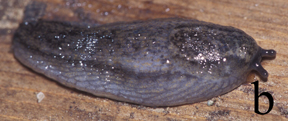
530a. Body sides with a yellow or orange band just ventral to black body bands (usually lacking in young individuals). Arion fasciatus
530b. Body sides without yellow or orange bands. 540
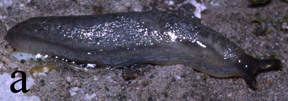
540a. Back uniformly dark gray, mantle flecked with black spotting. Arion circumscriptus
540b. Back medially dark gray and laterally brown. Arion sylvaticus
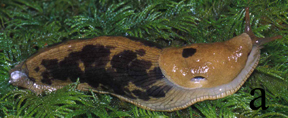
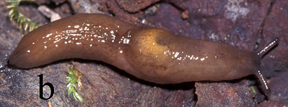
550a. Body color olive-greenish to yellow, with or without black spots or blotches; caudal pore conspicuous, nearly filled with a plug of mucous tissue; sole not longitudinally divided. Ariolimax columbianus
550b. Slugs not olive greenish to yellow; caudal mucus gland lacking; sole tripartite, having three longitudinal sections. 560


560a. Mantle smooth, without concentric wrinkles; keel extending from end of tail forward to posterior part of mantle. 561
560b. Mantle with concentric wrinkles reminiscent of a fingerprint; keel shorter, not reaching forward to mantle, usually restricted to posterior third of body. 570
a 
561a. Breathing hole slightly behind middle of mantle; up to 50 mm long in motion; subterranean in habit; introduced from Europe. Boettgerilla pallens
561b. Breathing hole in posterior third to fourth of right side of mantle; 14 to 23 mm long in motion; less subterranean; native species. Zacoleus sp.


570a. Tail tapering to a point when viewed laterally; with stripes or spots; nucleus of concentric wrinkles on mantle located on midline; posterior margin of mantle obtusely angular; full-grown slugs > 50 mm in length when in motion. Limacidae. 580
570b. Tail truncated when viewed laterally; usually lacking prominent stripes or spots; nucleus of concentric wrinkles on mantle located on right side above breathing hole; posterior margin of mantle rounded; full-grown slugs < 50 mm in length when in movement … Deroceras (formerly classified in genus Agriolimax). Agriolimacidae. 590


580a. 100 to 200 mm in length; body base color yellowish gray with conspicuous black spots; spots on mantle not arranged in two longitudinal stripes. Limax maximus
580b. 50 to 70 mm long in motion; grayish body with a broad, dark stripe on each side of the body; stripes on mantle. Lehmannia valentiana
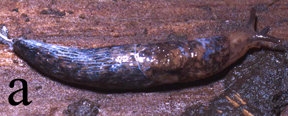
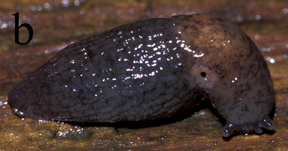
590a. Breathing hole with a pale border; mucus sticky, milky white when animal is irritated, otherwise clear; 35 to 50 mm long. Deroceras reticulatum
590b. Breathing hole border either pale or not; mucus clear, never white, not very sticky; less than 35 mm long. 600


600a. Up to about 25 mm; color fairly uniform, dark brown, amber, or purplish-gray; sole dark; breathing hole border not paler than rest of mantle; mantle length about half of length from front of mantle to tail. Deroceras laeve
600b. Length 28 to 32 mm; body dark brownish gray, mantle usually paler orange-brown; sole pale; breathing hole border usually paler than rest of mantle; mantle length about a third of length from front of mantle to tail. Deroceras panormitanum
![]()